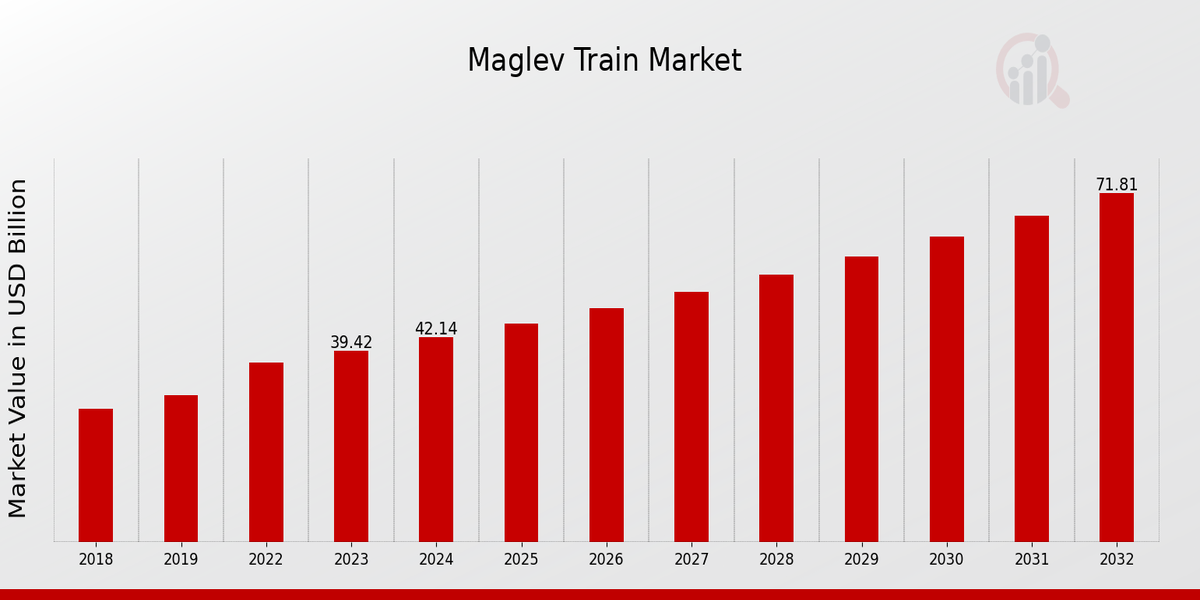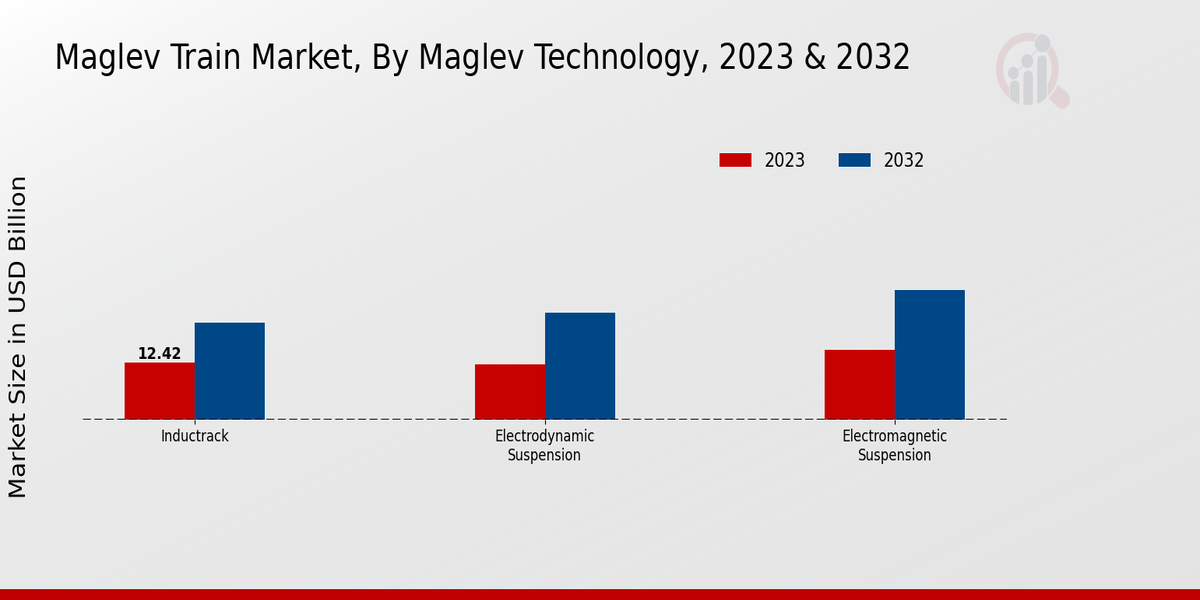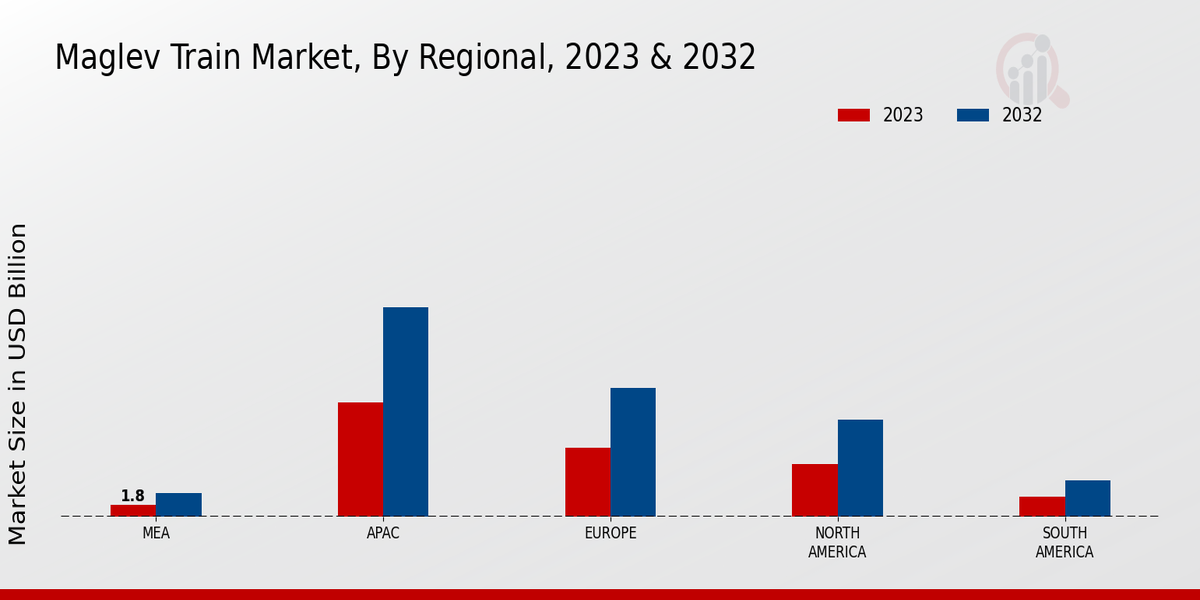Global Maglev Train Market Overview
As per MRFR analysis, the Maglev Train Market Size was estimated at 36.88 (USD Billion) in 2022.The Maglev Train Market Industry is expected to grow from 39.42 (USD Billion) in 2023 to 71.8 (USD Billion) by 2032. The Maglev Train Market CAGR (growth rate) is expected to be around 6.89% during the forecast period (2024 - 2032).
Key Maglev Train Market Trends Highlighted
The Maglev Train Market is witnessing robust growth driven by an increasing emphasis on sustainable transport solutions and the need for faster, more efficient rail systems. The demand for eco-friendly transportation options, combined with advancements in technology, is propelling the adoption of magnetic levitation trains. These systems not only reduce the environmental impact associated with traditional rail transport but also enhance passenger experience through reduced travel times and increased comfort. Furthermore, government initiatives worldwide to improve transportation infrastructure are seen as key market drivers as investments in high-speed rail networks become a priority.
Opportunities abound as urbanization accelerates globally, leading to higher population densities in metropolitan areas that necessitate innovative transit solutions. The growing interest in public transportation due to traffic congestion and air pollution is making maglev trains an attractive option for urban transit systems. Additionally, investments in research and development could unlock next-generation maglev technology, enhancing performance and reducing costs. Partnerships between public entities and private sector innovators can create pathways for deploying maglev systems in more regions, enabling broader access to advanced rail technologies.Recently, trends toward increased automation and smart technologies in public transportation are aligning well with the capabilities of maglev trains. The integration of digital systems for operations and customer experience is becoming more prevalent, enhancing operational efficiency and providing real-time information to passengers. Moreover, developments in magnetic materials and power supply systems are improving the viability of maglev trains for longer distances, setting the stage for expansive networks that interconnect major urban centers. The focus on safety and reliability in high-speed transit systems is also driving innovations, as stakeholders aim to create safe and seamless travel experiences for commuters.
Overall, the future of the maglev train market appears promising, with numerous avenues for growth and technological advancements paving the way for a revolution in public transportation.

Source: Primary Research, Secondary Research, MRFR Database and Analyst Review
Maglev Train Market Drivers
Increasing Demand for High-Speed Transportation
The Maglev Train Market Industry is witnessing a significant shift towards high-speed transportation systems as urbanization and population growth put pressure on existing transportation infrastructures. Traditional train systems often face limitations in speed and efficiency, leading to longer travel times and increased congestion. On the other hand, Maglev trains utilize magnetic levitation technology, allowing trains to glide over tracks without friction, which enables them to achieve incredibly high speeds, often exceeding 300 km/h.This capability is becoming crucial as cities seek to develop more integrated and efficient public transportation solutions. Additionally, as the demand for rapid intercity and cross-border travel increases, Maglev technology presents a compelling alternative. The focus on reducing travel time between major metropolitan areas not only enhances productivity but also stimulates economic growth. Furthermore, government policies worldwide are increasingly favoring investments in advanced rail technologies, also promoting environmental sustainability through reduced carbon footprints associated with public transit.In essence, the move towards Maglev systems reflects a broader trend to modernize transportation infrastructure in line with 21st-century demands and technological advancement, thus driving the market growth of the Maglev Train Market Industry.
Government Initiatives and Investments
Government initiatives play a pivotal role in the growth of the Maglev Train Market Industry. Many countries recognize the need to modernize transportation systems to accommodate growing populations and alleviate congestion. Significant investments are being made in research and development, construction of new Maglev lines, and upgrading existing transit systems. These investments not only help to revitalize economies but also demonstrate a commitment to sustainable and efficient public transport solutions.Furthermore, public-private partnerships are becoming more common, allowing for shared financial risks and collaborative innovation in Maglev technology.
Technological Advancements in Maglev Systems
Technological advancements continue to enhance the performance and cost-effectiveness of Maglev trains. Innovations in magnetic levitation systems, train design, and energy efficiency are making Maglev trains more attractive to potential investors and governments. The Maglev Train Market Industry is benefitting from state-of-the-art technologies that improve speed, safety, and passenger comfort, driving demand for new projects. As technology evolves, there is also a growing focus on integrating smart technologies into the Maglev infrastructure, further positioning the industry for significant growth in the coming years.
Maglev Train Market Segment Insights:
Maglev Train Market Maglev Technology Insights
The Maglev Train Market is poised for remarkable growth, with its value estimated at 39.42 USD Billion in 2023 and projected to reach 71.8 USD Billion by 2032. The segment of Maglev Technology plays a crucial role in this dynamic landscape, underscoring its significance in the advancement of transport innovation. Major components of this segment include Electromagnetic Suspension (EMS), Electrodynamic Suspension (EDS), and Inductrack. The Electromagnetic Suspension (EMS), valued at 15.0 USD Billion in 2023, represents a significant portion of the market, reflecting its essential function in maintaining operational stability and safety, enhancing the overall travel experience. The Inductrack, with a valuation of 12.42 USD Billion in 2023, also holds a vital place in the market by providing efficient levitation and propulsion technology, which contributes to reduced operational costs and energy efficiency. Furthermore, the Electrodynamic Suspension (EDS) is valued at 12.0 USD Billion in 2023 and is recognized for its ability to operate with high-speed trains, making it a preferred choice among various rail operators.
As the market progresses toward 2032, Electromagnetic Suspension (EMS) is anticipated to grow to 28.0 USD Billion, signifying its majority holding and dominance due to the technological advancements it incorporates. The EDS segment is projected to reach 23.0 USD Billion, reflecting its lucrative prospects thanks to the increasing demand for high-speed travel and reliability. Comparatively, the Inductrack, expected to grow to 20.8 USD Billion, highlights its cost-effectiveness and its pivotal role in sustainable transport solutions
, which are increasingly sought after in urban landscapes. Growth drivers for the Maglev Train Market include urbanization, the need for high-speed transportation, and environmental sustainability, as Maglev trains are known for their minimal air resistance and lower operational emissions. However, challenges such as high initial investment costs and infrastructure development may hinder progress. Nonetheless, the opportunities for innovation, particularly in the EMS and EDS segments, present a substantial growth potential as technological advancements continuously improve train speed, safety, and efficiency. The overall Maglev Train Market data reflects these ongoing trends, with strong growth expected across all segments and a clear indication that investment in Maglev technology is increasingly recognized as a major contributor to future transportation networks.

Source: Primary Research, Secondary Research, MRFR Database and Analyst Review
Maglev Train Market Train Type Insights
In 2023, the Maglev Train Market was valued at 39.42 billion USD, reflecting a growing interest in advanced transit systems. The market segmentation based on Train Type includes Passenger Trains, Freight Trains, and Mixed-Use Trains, each playing a vital role in the overall dynamics of the industry. Passenger Trains dominate this segment as urbanization and the demand for faster transit options increase, while Freight Trains are gaining traction due to the need for efficient and timely goods transport, creating opportunities for logistical enhancements.Mixed-Use Trains are also becoming significant as they cater to both passenger and freight needs, enabling cities to optimize infrastructure effectively. The Maglev Train Market data showcases a clear trend towards high-speed rail systems that promise a reduction in commute times and enhanced energy efficiency. With projected growth in market statistics showing a valuation of 71.8 billion USD by 2032, the importance of each Train Type in elevating transit systems cannot be overstated as they collectively address urban mobility challenges and contribute to sustainable transportation solutions.
Maglev Train Market Operational Speed Insights
The Maglev Train Market focuses significantly on Operational Speed, contributing to the market's overall dynamics and growth. As of 2023, the market is valued at 39.42 USD Billion, and it is projected to hold substantial growth potential in the coming years, addressing the increasing demands for efficient transportation solutions globally. Within the spectrum of operational speeds, each category plays a crucial role; the low-speed range of up to 100 km/h supports urban transit systems, making it vital for increasing connectivity in densely populated areas.Meanwhile, the medium-speed range of 100-300 km/h serves as a bridge for regional travel, offering a practical solution that balances speed and energy efficiency. The high-speed category, surpassing 300 km/h, dominates the market due to its appeal for long-distance travel, dramatically reducing transit times and enhancing the feasibility of high-speed rail networks. This segmentation aligns with the Maglev Train Market data, showcasing how the specific requirements and applications of each category drive the industry. As market growth continues, addressing these varied operational speeds will remain essential to harnessing opportunities and meeting transportation needs effectively.
Maglev Train Market Power Source Insights
The Maglev Train Market, particularly within the Power Source segment, has demonstrated significant growth potential, contributing to a broader market value of 39.42 billion USD in 2023, with a projected increase to 71.8 billion USD by 2032. The primary focus in this segment lies in three key areas: Electricity, Hybrid Systems, and Alternative Energy. Electricity serves as the backbone of maglev train operations, reflecting a dominant position due to its efficiency and reliability in powering high-speed transit systems. Hybrid Systems combine traditional energy sources with alternative options, presenting a growing solution that caters to network versatility and sustainability requirements.Additionally, Alternative Energy is gaining traction, driven by global initiatives toward eco-friendly transportation solutions, reflecting a major shift toward reducing carbon footprints. Overall, the market growth in the Power Source segment is bolstered by advancements in technology, increasing environmental consciousness, and government support for innovative rail systems, indicating a robust and dynamic industry landscape for the Maglev Train Market.
Maglev Train Market Infrastructure Setup Insights
The Maglev Train Market is positioned for robust growth within its Infrastructure Setup segment, which is projected to realize significant investments by 2023. This sector encompasses essential elements critical to the functionality of Maglev train systems, including Dedicated Tracks, Integrated Transportation Systems, and Urban Transit Solutions. The development of Dedicated Tracks is fundamental, as it ensures safety and efficiency for high-speed travel, while Integrated Transportation Systems play a vital role in harmonizing various modes of transport to boost connectivity and streamline passenger experience.Furthermore, Urban Transit Solutions have gained traction due to increasing urbanization, augmenting the demand for efficient public transport systems. Combined, these elements foster a comprehensive infrastructure framework necessary for achieving the overarching objectives of the Maglev Train Market. The market growth is fueled by urban development, government initiatives, and technological advancements. However, challenges such as high initial costs and regulatory hurdles could affect project timelines. Nonetheless, opportunities in sustainable transport and public-private partnerships are set to enhance the performance of the Maglev Train Market, demonstrating the importance of the Infrastructure Setup segment in driving the industry's progression.
Maglev Train Market Regional Insights
The Maglev Train Market is experiencing notable growth, particularly across its regional segments. In 2023, the Asia Pacific region will dominate with a valuation of 16.76 USD Billion, making it a significant player due to its advanced rail infrastructure and increasing urbanization. Europe follows with a valuation of 10.18 USD Billion, benefiting from ongoing investments in high-speed rail technology. North America, valued at 7.74 USD Billion, is also a key market, driven by infrastructure developments and modernization efforts. The Middle East and Africa segment, although smaller, holds a valuation of 1.8 USD Billion in 2023, indicating potential growth opportunities as countries look to enhance their transport systems.South America presents a valuation of 2.94 USD Billion, reflecting an emerging interest in sustainable transport solutions. The diverse market growth dynamics, combined with the push for efficient and environmentally friendly transit options, highlight the increasing importance of the Maglev Train Market revenue across these regions. The substantial investments and strategic initiatives in sectors such as infrastructure development and urban mobility underscore the promising future of the Maglev Train Market industry.

Source: Primary Research, Secondary Research, MRFR Database and Analyst Review
Maglev Train Market Key Players And Competitive Insights:
The competitive insights of the Maglev Train Market reveal a dynamic landscape driven by technological advancements and increasing investments in transportation infrastructure. This market has captured the attention of various stakeholders, including governmental bodies, private enterprises, and research organizations, as nations race to modernize their rail systems with faster, more efficient modes of travel. The competitive environment is influenced by key factors such as innovation in magnetic levitation technology, strategic partnerships, and collaborations aimed at enhancing operational efficiency and reducing costs. The global pursuit of sustainable transport solutions further amplifies the competitiveness, fostering the entry of new players and the expansion of existing ones in diverse regional markets. As countries focus on reducing carbon emissions and improving public transport reliability, the competitive forces shaping the Maglev Train Market are increasingly sophisticated, emphasizing the importance of technological leadership and robust project management.Hitachi, Ltd. stands out as a formidable player in the Maglev Train Market, leveraging its extensive experience in the transportation sector and its innovative technologies in maglev systems. The company has established a strong market presence, particularly in regions prioritizing advanced rail solutions. Hitachi's strengths lie in its commitment to research and development, which enables the continuous enhancement of its maglev technologies. The company's notable track record in successfully executing large-scale infrastructure projects underlines its reliability and operational efficiency. Moreover, Hitachi's strategic partnerships with government agencies and other key stakeholders enhance its capabilities in delivering state-of-the-art maglev systems. This approach not only solidifies Hitachi's standing in the market but also positions it favorably for future growth as the demand for high-speed rail transportation escalates globally.Cobra Group has carved out a niche in the Maglev Train Market, focusing primarily on innovative design and construction solutions tailored for maglev projects. Known for its engineering excellence, Cobra Group excels in delivering bespoke solutions that cater to the specific needs of clients in the rail industry. The flexibility and adaptability of Cobra Group enable it to respond effectively to emerging market trends and client requirements, thereby fostering strong customer relationships. Additionally, the company emphasizes sustainable practices in its operations, aligning with the broader industry goals of reducing environmental impact and promoting public transport efficiency. Cobra Group's proficient management and execution of significant maglev projects have contributed to its reputation as a reliable and forward-thinking player in the market. This focus not only enhances their competitive edge but also ensures they remain relevant in an ever-evolving landscape where speed and reliability are paramount.
Key Companies in the Maglev Train Market Include:
- Hitachi, Ltd.
- Cobra Group
- Thales Group
- Mitsubishi Heavy Industries
- General Electric
- Bombardier Transportation
- Kawasaki Heavy Industries
- CRRC Corporation Limited
- Siemens AG
- Alstom SA
Maglev Train Market Industry Developments
Recent developments in the Maglev Train Market have highlighted significant advancements in technology and increasing investments aimed at infrastructure development. Countries like Japan and China continue to lead in Maglev technology, showcasing improvements in speed and efficiency, with new routes and expansions being announced. The Japanese government is pushing forward its Chuo Shinkansen, set to connect major urban areas with cutting-edge Maglev trains by 2027. Meanwhile, there is a growing interest in sustainable transport solutions, with Maglev trains being seen as a viable option to reduce carbon footprints. This trend is encouraging collaborations between governments and private companies to explore innovative financing models for future projects. In the European region, there are discussions about integrating Maglev systems into existing rail networks, enhancing connectivity and reducing travel times. As the global emphasis on reducing travel-related emissions continues to rise, the Maglev train market is poised for growth, driven by technological advancements and increasing public interest in rapid transit options. The market's projected growth reflects both the need for faster transportation solutions and the positive response to environmental concerns.
Maglev Train Market Segmentation Insights
- Maglev Train Market Maglev Technology Outlook
- Electromagnetic Suspension (EMS)
- Electrodynamic Suspension (EDS)
- Inductrack
- Maglev Train Market Train Type Outlook
- Passenger Trains
- Freight Trains
- Mixed-Use Trains
- Maglev Train Market Operational Speed Outlook
- Low Speed (up to 100 km/h)
- Medium Speed (100-300 km/h)
- High Speed (above 300 km/h)
- Maglev Train Market Power Source Outlook
- Electricity
- Hybrid Systems
- Alternative Energy
- Maglev Train Market Infrastructure Setup Outlook
- Dedicated Tracks
- Integrated Transportation Systems
- Urban Transit Solutions
| Report Attribute/Metric |
Details |
| Market Size 2022 |
36.88 (USD Billion) |
| Market Size 2023 |
39.42 (USD Billion) |
| Market Size 2032 |
71.8 (USD Billion) |
| Compound Annual Growth Rate (CAGR) |
6.89% (2024 - 2032) |
| Report Coverage |
Revenue Forecast, Competitive Landscape, Growth Factors, and Trends |
| Base Year |
2023 |
| Market Forecast Period |
2024 - 2032 |
| Historical Data |
2019 - 2023 |
| Market Forecast Units |
USD Billion |
| Key Companies Profiled |
Hitachi, Ltd., Cobra Group, Thales Group, Mitsubishi Heavy Industries, General Electric, Bombardier Transportation, Kawasaki Heavy Industries, CRRC Corporation Limited, Siemens AG, Alstom SA |
| Segments Covered |
Maglev Technology, Train Type, Operational Speed, Power Source, Infrastructure Setup, Regional |
| Key Market Opportunities |
Highspeed urban transport demand Sustainable transit solutions Government investment incentives Technological advancements in propulsion Expansion in developing countries. |
| Key Market Dynamics |
Technological advancements Government investments Environmental sustainability focus Urbanization and infrastructure growth Rising demand for efficient transport |
| Countries Covered |
North America, Europe, APAC, South America, MEA |
Frequently Asked Questions (FAQ) :
The Maglev Train Market is expected to be valued at 71.8 USD Billion in 2032.
The expected CAGR for the Maglev Train Market is 6.89 from 2024 to 2032.
The APAC region holds the largest market share, valued at 30.81 USD Billion in 2032.
The Electromagnetic Suspension segment is expected to be valued at 28.0 USD Billion in 2032.
Key players in the market include Hitachi, Ltd., with significant contributions to market growth.
The Electrodynamic Suspension segment is projected to be valued at 23.0 USD Billion in 2032.
North America is expected to reach a market size of 14.24 USD Billion in 2032.
The Inductrack segment is expected to be valued at 20.8 USD Billion in 2032.
The European market is projected to reach 18.92 USD Billion in 2032.
The South American market is anticipated to be valued at 5.35 USD Billion in 2032.
























